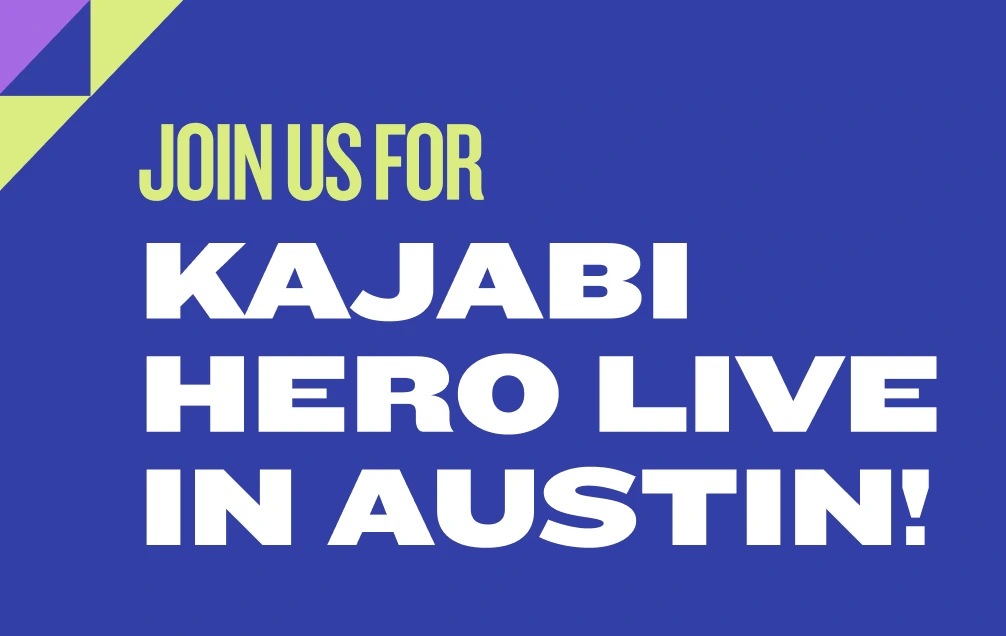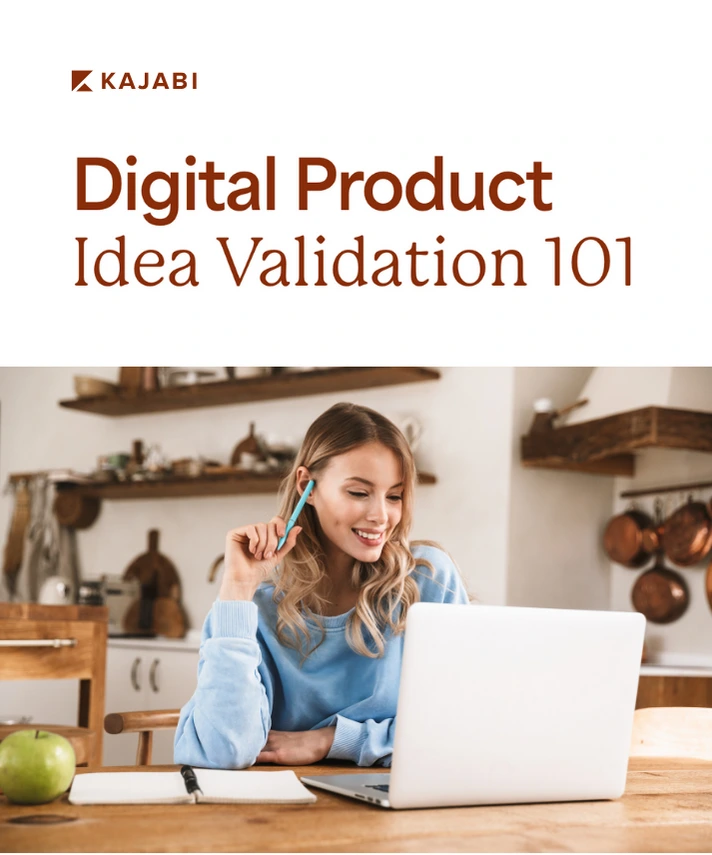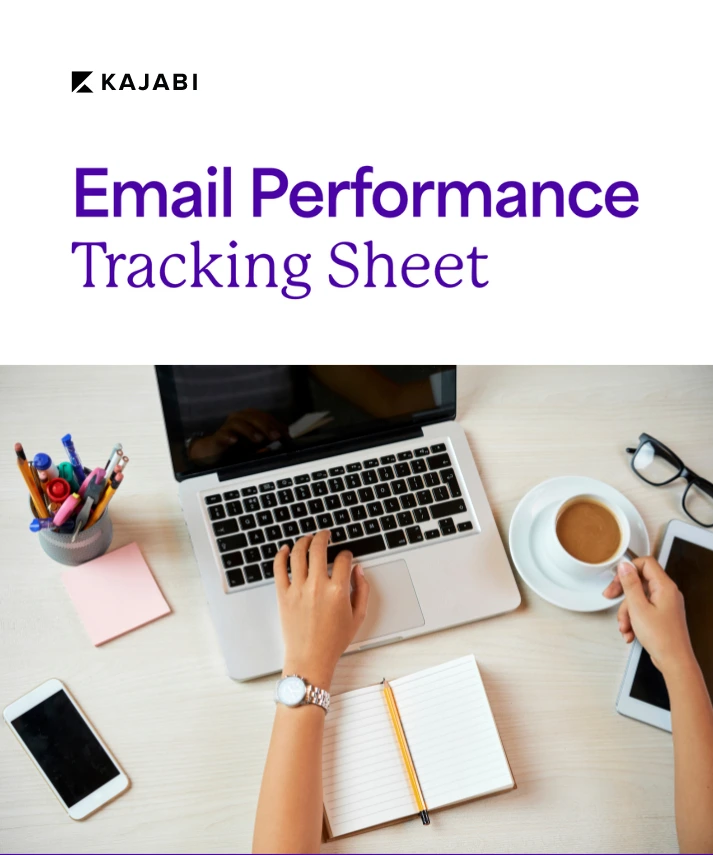
How to start a business selling digital products
Get free expert insights and tips to grow your knowledge business sent right to your inbox.
Do you dream about someday starting your own business? About breaking free from the rat race and controlling your destiny?
Keep reading, because that day may be closer than you think.
Owning your own business used to be little more than a dream. Today, in our digital world, you can start a business selling digital products in less than a week.
In this guide, you’ll learn our 5-step process for going from zero to hero. You’ll learn how to develop your idea, why it’s so smart to use a website builder like Kajabi to set up your online business, and how to quickly set up your marketing like a pro, even if you’ve never done it before.
But first, let’s lay the foundation.
{{lean-canvas}}
Read the 2022 State of the Creator Economy Report to get the latest data on industry trends and growth for knowledge content creators.

What are digital products
Digital products are intangible products that exist in digital format. Think digital courses, ebooks, software, music files, and Netflix movies. Any product that you buy and use without actually touching is a digital product.
Because digital products don’t have physical substance, they’re easy to store and easy to use. They don’t require trees to be cut down. They don’t take up any floor space.
In most cases, digital products are sold online and delivered through digital channels. For instance, a digital course may be:
- Hosted on a learning platform like Kajabi
- Promoted on a website
- Paid for through a digital shopping cart
- Delivered via email
The course, a collection of modules and lessons presented through video and written lessons, is a digital product. The website, shopping cart, and email software that sell and deliver the course — all digital products.
Unlike physical products, which take up physical space, digital products are intangible. Yet they are every bit as valuable. A course or ebook offers knowledge. A website and shopping cart enable entrepreneurs to run a business from anywhere in the world. Email has all but replaced physical mail for communicating with one another.
Today, digital products are often seen as more valuable than physical products. That makes them the perfect offer for a digital business.
Why should I start selling digital products?
We’ve already established that digital products are a good product for any business. Let’s now look at 7 reasons why you should start a business selling digital products.
Your knowledge is valuable
If you’ve got knowledge that other people want, you can create digital products and start a business selling them. It’s easy to discount your own knowledge, but there are other people who want to know what you know. And they’re willing to pay top dollar to gain that knowledge.
Low overhead
Starting a digital business is far more affordable than starting a physical business. You don’t need to rent a building, pay for product development, or find warehouse space. Many digital businesses were started with pocket money: just enough to build a website and create a video or PDF.
A digital business is easy to run
A business selling digital products is one of the easiest businesses to start and run. A digital product can be built over a weekend. Some are even sold before they’re created. And you can build a successful business around that one product.
It’s also possible to run a digital business almost on autopilot. Once they’re set up, your marketing can be automated to do all the heavy lifting for you. That frees you up to focus on your customers, create another digital product, or spend time with your family and friends.
A digital business gives you freedom to live where you like
Because a digital business doesn’t have a storefront, it can go wherever you go. You’ll run your business from your laptop and phone. Which means you have the freedom to live wherever you wish.
No office politics
As a business owner, it’s just you, your cat or dog, and whoever else you want to work with. There are no office politics when you’re the boss. No one cares how big (or small) your office is!
You get to do what you love every day
When you’re sharing your expertise, helping other people succeed, and doing what you love every day, it doesn’t feel like work. Instead of taking a job helping another company succeed, you get to spend every day focusing on the things that are most meaningful to you.
There’s no limit to your growth and income potential
Most knowledge entrepreneurs don’t start a business to get rich. But it happens more often than you think.
When you create a course that resonates with your students, and when you dial in the marketing, you’ll be surprised at how quickly your business grows. Once that happens, your income will grow as well.
According to Steve Siebold, self-made millionaire and author of How Rich People Think:
“While world-class thinkers understand the importance of saving and investing, they direct their mental energy toward accumulating wealth through serving people and solving problems.”
As a course creator, you’re spending your mental energy where it counts. By serving your students and solving their problems, you’re laying the foundation for unlimited growth and income.
Do I need special skills or training to start a business?
New entrepreneurs with great ideas often hold back because they’re afraid they don’t have the skills or training to start a business. If that’s you, rest assured, you’re in good company. Most successful businesses were launched by people who had a great idea but no idea about how to run a business.
Let’s look at some of the biggest worries we see from wanna-be entrepreneurs, and why you don’t need to hold yourself back.
“I don’t know anything special”
I’m going to stop you right there. You do know something special. And there are people in the world who want to learn from you.
Too often, we take our own skills and knowledge for granted. They come easily to us, so we think they’re easy for everyone. But what’s easy for you is hard for other people. They’d love for you to show them how you do what you do, from how you think about it to how you navigate the challenges.
You may also think that your skills aren’t valuable enough, that people wouldn’t be willing to pay for a course that teaches them how to do what you do. Let me say it again: People want to know how to do what you do.
To allay your fears, here are a few wildly successful businesses on offbeat topics:
The Doodle Institute, Doodling

Founder Diane Bleck created the Doodle Institute to reach and share her passion for doodling. She now serves thousands of people around the world who were told as a kid that doodling is a waste of time.
Diane offers three basic courses and three advanced courses. She also sells doodling supplies, making her site a one-stop shop for doodlers.
Doodling isn’t the first thing that comes to mind when you think about a profitable skill. But Diane has built a successful business teaching people how to be a better doodler, how to be more creative, and how to use doodling at work, school, and home.
Lauren Bongiorno, Diabetes health coach

Lauren didn’t intend to start a coaching program for Type-1 Diabetics. Nor did she think, “Someday, I’ll be the Resident Diabetes Health Coach for Omnipod.” She was set on a more traditional career in law.
Diagnosed with diabetes at age 7, she knows first-hand the struggle it can be to manage. At 19, her doctor reported that her A1C was the lowest it had ever been, but despite the good news, she didn’t feel like celebrating.
“On paper I was healthy, but deep down inside I didn’t feel that way.”
Today, Lauren coaches people all over the world to achieve optimal diabetes management and feel supported and in control.
Sometimes, your business idea doesn’t sound like a business idea at all. It’s something you experience on a daily basis. But you’ve learned management skills that others would benefit from, or you want to provide a community for other people just like you.
Simply by leaning into your challenge, you can unlock opportunity. Lauren isn’t just a business owner. She’s now an ambassador for Lululemon, on the global council for Beyond Type 1, the Resident Diabetes Health Coach at Insulet, and was recently nominated by Pure Wow as one of the Top 100 entrepreneurs to watch.
Somatopia, Somatic Psychology

Dr. Albert Wong is the former Director of Somatic Psychology at John F. Kennedy University. Arguably, he knows a lot of important stuff. But most people might argue that his topic is so advanced, there isn’t an audience for it.
That didn’t stop Dr. Wong from building a successful business teaching what he knows best.
Here’s the difference: While he doesn’t turn away anyone who wants to learn, he doesn’t market his course to you and me. His target is leaders, directors, and clinicians.
The same can be true for you. It doesn’t matter what your experience or knowledge is, there’s an audience waiting to learn from you. You just need to decide that you’re willing to step up and share what you know.
“I don’t have any special training”
We’ve touched on this already: You don’t need a degree or special training to start a business. As a course creator or coach, it’s your experience that gives you credibility.
Here’s what really matters when you’re starting a business:
- You’ve found solutions that other people want to learn
- You’re able to break down that knowledge into a step-by-step process that other people can implement on their own
Rather than focusing on special training, get started building your business. Your track record helping other people succeed will almost always give you more credibility than specialized training will.
“I’m not techy enough”
It’s not 1995 anymore. You don’t need to know HTML or a fancy computer language to start a business online. Today, you only need the right tools to start and grow your business.
Until recently, business owners struggled to find the right tools and integrate them so they played nice together. But you don’t need to worry about that if you choose platforms like Kajabi.
Our goal is to make it easy to start a business. So we’ve bundled all the tools you need into one platform:
- Website
- Landing page builder
- Shopping cart
- Email marketing
- Funnel builder
- Analytics
Seriously, not being techy is the last thing you should worry about. Today’s technology is easy to use and easy to learn. If you can use a smartphone, you’ve got the tech skills you need to build a business.
“I don’t know anything about running a business”
Even if you have a business degree, the knowledge you acquired in school won’t likely help you start a digital business. Business knowledge is best learned doing it. And the skills you’ll actually use are best learned in the trenches.
Besides, there’s plenty of information online when you need to figure something out. The Kajabi blog is full of guides (just like this one) that teach the tactics you’ll use most.
Here are a few examples:
- How Email Marketing Works: The Complete Guide
- What Is a Landing Page: Different Types & Why Should You Use Them?
- How to create a profitable online course: A step-by-step guide to success
Now, let’s look at someone who started her business without a lot of business experience.

Amy Porterfield didn’t have a business degree when she decided to start a business. Her degree was in Communications. And she’d spent her career doing content marketing for Tony Robbins, Dream Foundation, and Harley-Davidson.
Today, Amy is a Kajabi Hero. Her business is thriving.
And yes, there was a learning curve. Amy talks frequently about the challenges of figuring things out in her first few years. But not only has she overcome those challenges, she’s harnessed them to create blockbuster courses that help her students succeed right away.
{{lean-canvas}}
How to start selling digital products based on your knowledge
Ready to start a business selling digital products? You can get started in just five steps.
Step 1. Decide what your business will be
Before doing anything else, get clear about what you want your business to be. You don’t have to have all the details ironed out, but you do need to know three pieces of vital information:
- Who you serve
- The problem you solve
- How you solve it
Decision #1: Who you serve
When you come up with your business idea, you need to make sure there’s a market for it. Are there people who are clamoring to learn what you’re teaching? And more importantly, are they willing to pay to learn that information?
Many businesses have launched and failed because they didn’t run their idea through this simple test. They came up with an idea they loved, but they didn’t verify that potential customers were interested.
A quick way to validate your idea is to use a keyword tool like Ubersuggest to check the search volume of the keywords related to your idea.
For instance, let’s say you want to create a course on baking pies. Here are the top keywords and their monthly search volume:
- Baking pies = 1,600
- How to bake pies = 720
- Make pies = 720
Just 720 searches on how to make pies? That’s not great. Baking pies might be too narrow of a topic. Let’s try some related keywords:
- Baking desserts = 5,400
- Baking desserts recipes = 1,900
- Learn to cook = 4,400
- Bread baking = 49,500
This research reveals that there are a limited number of people searching online for information on baking desserts or even cooking in general. But there are a lot of people searching for information on bread baking. If you want to create a cooking course, bread baking may be the best place to start.
Now, let’s take your test to another level. Do a quick video of yourself baking bread. Share it on social media and ask your followers if they’d be interested in joining a new course you’re creating on bread baking.
Your goal at this stage is to see if people are willing to learn from you. If a handful of people express interest, you can confidently move forward on creating your course.
Tip: If your idea has 10,000+ search volume, you have a valid idea. If you can launch a beta course right away, all the better. But that’s not absolutely necessary to start your business. You may need to build an audience before getting people into your beta course.
Decision #2: The problem you solve
People don’t buy products. They buy solutions. Your digital product needs to solve a tangible problem that’s preventing your audience from achieving their goals.
You may already know the problem you’ll solve. If so, great! If not, think carefully about the transformation you’re offering your customers. It needs to be something they care about.
If you aren’t clear, that’s okay. Schedule some coffee chats with people who fit your customer profile. Tell them about what you’re doing. Ask them, if your product could magically solve any problem for them, what that would be.
Use that data to help you identify the real problems you’re solving. If necessary, adjust your product idea so it clearly addresses these problems.
Decision #3: How you solve it
It’s easier to sell digital courses and coaching if your solution relies on a proprietary system or method. Once you’ve nailed down the problem you solve, think about how you solve it.
- How many steps are in the system?
- Can you give your system a name? This isn’t necessary, but it can help establish your brand.
- What outcome can people expect after following your system?
Step 2. Build a website
Once you’ve validated your business idea, it’s time to start building your website. As a digital business, that’s your storefront.
Today, you can build a website in just a few hours, and you don’t need to know a single line of code. Platforms like Kajabi are designed specifically for creative entrepreneurs who want to start a business selling digital products. They make it easy to build a beautiful website in just a few clicks.
What does your website need?
To sell digital products on your website you need to make sure you have these functionalities:
- Creating forms, so visitors can easily join your list
- Building landing pages, so you can tell people about your products
- Accepting payments, so you can sell your products
What are the steps to build your website?
Start by securing your domain name. Make a list of names that you like, and plug them into GoDaddy to see if they’re available.

Sadly, most good names are already taken, so be prepared to spend some time playing around with variations of your ideas.
Next, choose your hosting company. If you go with an all-inclusive platform like Kajabi, they take care of your hosting, as well as the functionality we listed above.

Once you’ve secured your hosting, you’ll need to connect your domain name to your website. Then you’re ready to begin building your web pages.
Your homepage should let your ideal customers know they’re in the right place. This can be done in just a few words:
- State your brand name or identify your target audience.
- Share your value statement or brand promise.
- You may also make a simple offer.
Here are some examples:
PrepWell Academy welcomes visitors, names their target audience, and makes a promise:

Rhythm Monster states the brand promise, then makes a simple offer.

Step 3. Build an audience to sell to
A business’s most valuable asset is their email list. These are people who have given you permission to send messages to their inbox. And they know, like, and trust you. That means there’s a high probability that they’ll buy from you.
To build your audience, you need to add people to your email list and begin sending emails to them. We call this process list building.
List building is the marketing strategy of giving people a freebie in exchange for their contact information. That freebie is called a lead magnet, because it magnetically attracts your best leads. It may be a digital product (like a piece of content), a physical product (like a book), or a sample of your product (like a short coaching session).
You can learn more about lead magnets here: How to Collect Emails Like Crazy
From a high level, the process looks like this:
- You create content that attracts people to your website.
- You send that traffic to a landing page that talks about your freebie.
- They fill out a form to access your freebie.
- You start sending emails to them.
Generally, email marketers adopt an 80:20 strategy. 80% of their emails inform and educate their subscribers. 20% make an offer. That helps you create tons of value for your subscribers, so they’re eager to open your emails and click through to your website.
Step 4. Create marketing and sales funnels
To start selling your digital products, you need to set up your marketing and sales funnels. Here’s what you’ll need to market and sell your digital products.
Landing pages
Landing pages are web pages that focus exclusively on selling a product or giving away a lead magnet. They may be long or short. Their one job is to attract your best prospects and convince them to take action on your offer.
Once you build a landing page for your lead magnet, you can begin building your email list. Build a landing page for your digital product, and you can start selling your product.
You don’t need to be a copywriter or an experienced marketer to build a good landing page. Great landing pages are written as if you’re talking to the prospect face-to-face. You only need to write like you talk.
You may also choose to create a video for your landing page. That’s a great way to engage your visitors.
Here’s how to create a strong landing page:
- Put an attention-getting headline at the top of the page.
- Tell your visitors about the benefits of your product.
- Tell them what they need to do to get the product.
- Then give your call to action: “Buy Now” or “Download It Here.”
{{lean-canvas}}
Funnels
Funnels are series of landing pages and email sequences that attract your target audience and sell your digital products.
If you’re new to marketing, funnels can seem complicated and difficult. But they’re easy to build, especially if you follow a proven blueprint and use templates for your landing pages.
If templates feel like cheating, don’t worry! Most marketers use templates to quickly design their funnels. Once the basic pieces are in place, they can edit and tweak those pieces to make them reflect their brand and voice.
That’s why Kajabi has built-in Pipelines. These blueprints have all the foundational pieces for the most frequently used funnels. Click a button to set up your funnel, then tweak the layout and sales copy to showcase your products.

Email sequences
Once people sign up for your lead magnet, you need to begin engaging with them. The best way to do that is through email sequences, set up in advance to go out automatically on a schedule you set.
As mentioned earlier, email marketing helps you build relationships with your subscribers. In your emails, you can remind them about the value they got from your lead magnet. And if they didn’t buy your product right away, you can continue marketing to them.
There’s no way to get this wrong: Send engaging emails that tell stories, teach, and inform. Remind your subscribers about your product. Include links that take them back to your landing page.
Step 5. Optimize your sites for conversion
With steps 1 through 4 done, you’re likely already selling your digital products. But there’s always room for improvement.
That’s why we recommend that you continue to optimize your site for conversions. To do that, you need to watch your numbers:
- Identify your most trafficked pages.
- Identify the pages that people don’t visit, or if they do, that they leave without taking action.
Then test ways to improve your results. Bottom line, you want to improve the things about your website that work and reduce the number of things that don’t work.
Your website needs to focus on one thing: selling your products. To do that, you need to reduce distractions. Make it clear what your website is about, so you attract people who want to buy from you. Then send them to your landing pages, where they can buy.
Tip: You want to have just one call to action on each page. Don’t be shy. Tell people clearly what you want them to do. Then reward them for taking the action you’ve asked for.

Build on your success and expand your business
The key to starting a business is taking action. In this guide, we’ve given you a five-step process for going from zero to hero.
To get started, decide what you’re selling, who you’re selling to, and how you get results for them. Then build your website, landing pages, funnels, and emails with proven templates and blueprints. They’ll save you hours of time trying to find what works.
Then pay attention to what works. Lean into those areas. If you listen to your customers and give them what they want, you’ll build a profitable business in no time.
But even with a digital business, it's smart to have a legal framework. Consider using an LLC service to ensure it's all set up properly.
Here are a few simple rules for growing a business:
- Watch your analytics. You need to know what’s working and what’s not.
- Always be testing. Small improvements in your marketing can add up to big profits.
- Do more of what works and less of what doesn’t work.
- One thing at a time. Establish your first course before building another.
{{lean-canvas}}
Bottom line
If you want to build a business selling digital products, the only thing holding you back is YOU. There will always be reasons to wait. But there’s never a better time than now to get started.
So start today. Follow our 5-step process, and turn your idea into a profitable business.
Start your free 14-day trial of Kajabi now!
More resources:
How to recover from a slow product launch
Best practices for using lead capture forms
What is segmentation & why should you use it?
Find more blog posts by category:
Create Your Product
Build Your Business
Grow Your Business
Kajabi News
Self-Made













